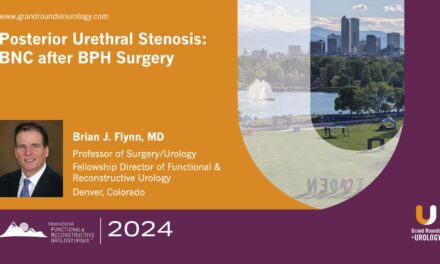Seung-June Oh, MD, PhD, presented “Sphincter-Saving Technique in HoLEP Surgery” for the Grand Rounds in Urology audience in July 2021.
How to cite: Oh, Seung-June. “Sphincter-Saving Technique in HoLEP Surgery” July 2021. Accessed Apr 2025. https://grandroundsinurology.com/sphincter-saving-technique-in-holep-surgery/
Sphincter-Saving Technique in HoLEP Surgery – Summary:
As part of Grand Rounds in Urology’s ongoing series highlighting urologists working in Asia, Seung-June Oh, MD, PhD, Professor of Urology at Seoul National University in Seoul, South Korea, explains and demonstrates his sphincter-saving technique for holmium laser enucleation of the prostate (HoLEP) surgery. After an introduction by Peter K.F. Chiu, MD, PhD, FRCSEd, Honorary Clinical Assistant Professor and Associate Consultant in the Division of Urology in the Department of Surgery at the Prince of Wales Hospital of the Chinese University of Hong Kong, Dr. Oh gives an overview of HoLEP, noting that it is becoming a more universally accepted transurethral surgery to treat benign prostatic hyperplasia (BPH) but has the potential to cause more harm to the sphincter than transurethral resection of the prostate (TURP) and sometimes results in stress urinary incontinence (SUI) post-operatively. He explains that the etiology of SUI after HoLEP is multifactorial, with age, general health status, past history of neurological disease, and accompanying bladder dysfunction all playing a role, but he argues that one of the most important factors urologic surgeons should pay attention to is the high degree of individual variation in the anatomy of the prostatic apex. This variation can make it difficult for surgeons to apply the same technique and get the same results. Dr. Oh then presents his 4 strategies to maximally preserve the continence mechanism during HoLEP, including (1) making the mucosal incision sufficiently early before starting full enucleation of lateral lobes, (2) forming bilateral mucosal wings at the apical prostate after enucleation of the median lobe, (3) making sure the starting point of the 12 o’clock mucosal incision is proximal to the sphincter, and (4) carefully preserving the mucosal tissues around the urethral sphincter. All together this constitutes Dr. Oh’s Early Inverted V-shaped Apical Mucosal (EVAMI) Technique, which he demonstrates via footage of a routine HoLEP surgery. The presentation concludes with a question and answer session in which Drs. Oh and Chiu discuss the learning curve for HoLEP, rates of early incontinence after using the EVAMI technique, and how powerful holmium laser machines should be.
ABOUT THE AUTHOR
Seung-June Oh, MD, PhD, currently serves as Professor of Urology at Seoul National University (SNU) College of Medicine in Seoul, South Korea. Over the past 25 years, Professor Oh has authored or coauthored over 220 peer-reviewed papers and has contributed to 16 book chapters, including a chapter in the ninth edition of Campbell’s Urology as the first author. He has also served as the principal investigator in 103 different research studies on the lower urinary tract dysfunction areas. His primary interest is in benign prostatic hyperplasia (BPH), overactive bladder, and neuropathic lower urinary tract dysfunction. He is particularly interested in research on the urodynamic aspect of bladder outflow obstruction associated with BPH and also in the holmium laser enucleation of the prostate, or HoLEP, for BPH. Professor Oh is an active member of several professional organizations, including the International Continence Society, the American Urological Association, and the Society of Urodynamics, Female Pelvic Medicine and Urogenital Reconstruction. He has served as the President of the Korean Continence Society since January 2016 and has also served as the President of the Pan-Pacific Continence Society.




